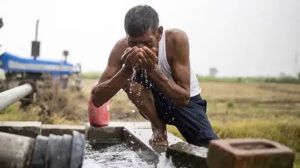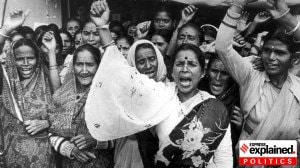Palanivel Thiaga Rajan at Idea Exchange: ‘It’s not about NEP…can you teach enough children one language properly in UP, Bihar?’
Palanivel Thiaga Rajan, also known as PTR, is one of the most articulate voices in the Dravidian politics of his party, the DMK, making a case against the Centre’s impending delimitation of constituencies and implementation of the National Education Policy (NEP)
 Palanivel Thiaga Rajan
Palanivel Thiaga RajanPalanivel Thiaga Rajan, Tamil Nadu Minister for IT and digital services, on the rationale behind the protests against the three-language formula, delimitation, bridging the North-South economic divide and India’s leverage in global markets. The session was moderated by Managing Editor P Vaidyanathan Iyer.
P Vaidyanathan Iyer: What prompted your government to change the rupee symbol from Hindi to a Tamil letter in the Budget? Is it a political statement to prove a point on the Centre’s three-language prescription in the National Education Policy (NEP)?
The Budget has just been presented. But there are 100 objections we have to the NEP. The primary issue is that we don’t believe in the notion of the NEP. Under the original Constitution, education was a State subject. And relatively speaking, the outcomes across states have been tremendously different over the last 75 years. In fact, the NEP today, much like many of the recycled ideas of this government, is not an original concept.
The first NEP was in 1968, the second in 1986, which was amended further in 1992. And this is the third with amendments. We have never accepted any of the NEPs, as we have been consistent from Day 1 that somebody sitting in Delhi should not tell us how we should run school education. We oppose moving school education to the Concurrent list from the State list. The NEP of 1968 recommended a three-language policy but made a distinction. It said that in Hindi-speaking states, there should be English-Hindi or rather Hindi-English combinations and a modern southern language. In non Hindi-speaking states, it recommended the use of the mother tongue, English and Hindi.
In 1986, the parliamentary bill itself admitted that in 18 years, the government had not been able to implement the three-language formula successfully in any place, primarily because of its inability to find the right kind of language teachers in the right places. The bill authors said very explicitly that even though they were recommending the three-language formula, they were doing so for the sake of national unity. They even said that if it was going to be implemented, decisions would have to be taken by the states because they entailed resource constraints and execution problems that could not be mandated or dictated from Delhi. So before we get into what the NEP contains, we are democratically opposed to the notion of somebody from Delhi setting the educational agenda for the state of Tamil Nadu. That’s the first point.

Second, our performance in the education sector over the last 75 years has been much better. Take any measure of educational progress, be it enrolment in higher education, the number of colleges and universities in the Top 100 or the number of patents filed, Tamil Nadu stands tall at number one in the country. For example, the goal for gross enrolment ratio for higher education set by the new NEP has already been crossed by us 10 years ago. So why should somebody in Delhi tell us how and what to improve?
P Vaidyanathan Iyer: Do you think the three-language policy is burdensome to schools? Do you have data about why it doesn’t work for Tamil Nadu?
As of today, there are roughly 1.08 crore students in Tamil Nadu schools, either government-run or private, under the state board of education. All of them follow the two-language formula. And just to be clear again, education is compulsory in Tamil Nadu. The Madras Presidency had passed the Elementary Education Act in 1920. We ensure compliance, bringing back truants to school. We introduced remedial education after Covid to close learning gaps. Education is that important to us. Since there has been rapid inclusion of children from poorer backgrounds and rural areas, many of them being first generation high school graduates, we didn’t want to burden them with three languages.
There are some thousand Kendra Vidyalayas (KV), CBSE and ICSE board schools which follow the three-language formula. In fact, data suggests that many of them are not being able to implement the three-language formula properly. In Tamil Nadu, KV schools have 109 Hindi teachers and 53 Sanskrit teachers but zero Tamil teachers for a third language. That’s the problem.
ON DELIMITATION GOALS | The implication of the 25-year freeze on delimitation was that states would level up. We have kept on increasing the net transfers from rich states to poor states but the gap has kept on widening
Story continues below this ad
My children go to an international school and all such schools are, to my knowledge, two-language. So if you look at it from that perspective, the overwhelming majority of students from the lowest end to the highest end are in a two-language formula. That has worked well for us. We see no reason to change that. Many people choose to do three languages outside of school.
Let me point out again that the headquarters of the Dakshin Bharat Hindi Prachar Sabha is located in Chennai as it has been from inception. And ours is the only state where they have two offices. Dakshin Bharat Hindi Prachar Sabha has headquarters in Chennai, a regional office in Trichy, then one in Kerala, one in Karnataka and one for the combined state of Andhra Pradesh and Telangana. They get many subsidies from the government of India. Anybody who wants to learn any language, go for it. We will not make it compulsory and overload the children’s learning curve. That’s all.
Liz Mathew: Many DMK MPs told us that they are not against Hindi, the language, but against its imposition. Language has played a key role in Dravidian politics as has caste. Do you think there’s a caste factor, too, in this debate?
There’s no caste factor at all. It is about anti-federalism and the Centre’s authoritarianism that has been going on for 11 years in every way, this time in the form of extra-constitutional conditions added in education. But they’ve also said if you want food, you have to put the Prime Minister’s name on it. All the schemes have to be in Sanskrit or Hindi. There are 100 ways they do it, from money allocation to the extremes of intentionally appointed, obstreperous and obdurate governors who refuse to sign bills. Then they send it back. Then we pass it again. Then they send it to the President. That’s not in the Constitution, the Supreme Court says so. So they are finding every way to obstruct the will of the people who elected us, their self-respect and right to self-determination.
So, do we see this NEP as part of the overall anti-federal authoritarian activities of the government of India? Absolutely so. There’s this notion of ultimate arrogance that they are kings as opposed to merely elected representatives, even though there’s no constitutional provision for them to tell you what to do.
Liz Mathew: While the BJP is taking on the DMK, the Prime Minister and other leaders are promoting Tamil culture. What do you think about this dichotomy?
If you have two faces, how long can you keep them separate from each other? But given the education and exposure Tamil people have, they can’t be fooled. In most cultures, calling somebody two-faced has a negative rather than a positive connotation. We’ll see.
Arun Janardhanan: The issue of language supremacy is older than DMK. The opposition to Hindi, which began in 1930, is the same when it comes to 2025. Is there any change in the so-called political necessity to oppose Hindi from the DMK’s perspective?
From the beginning, Hindi has always been an administrative tool. When Hindi imposition was first attempted during colonial rule in the 1930s, it led to riots and deaths. In the 1960s, it was attempted by the Congress government. If you talk to BJP leaders or anybody who controls Delhi, they would tell you that if you had one language, one uniform administrative tool, it would make their lives easier. But this means subjugation and the disappearance of identity, the homogenisation and removal of our diversity. This is an identity problem. I am referring to CN Annadurai’s (DMK founder) speech in the Assembly in 1963: “The consequence of the imposition of Hindi as the official language will create a definite, permanent and significant advantage to the Hindi-speaking states.”
Some values are in a culture that is thousands of years older than the language that is the oldest living language today. It’s hard for me to think of another issue that has brought such universal support from across the country, be it from Kerala, Karnataka, Maharashtra, even Uttar Pradesh and Bihar. So I think we have touched upon a nerve. No one person knows best, but no one person’s will should be imposed extra-constitutionally on the rest of the country.
On THE NORTH-SOUTH GAP | Our future will be determined by how we fix the core problems of the North because the South is only about 25 per cent of the population or less. If I were in Delhi, I would ASK STATES how WE could PARTNER FOR A GLOBAL MARKET
Arun Janardhanan: Union Education Minister Dharmendra Pradhan has said that funds under the Samagra Shiksha scheme will not be released unless the state government accepts the NEP in its entirety. How are you going to find funds?
We will never bow down to extortion. It is extra constitutional. There’s no provision in the Finance Bill that says you have to comply with certain things to get the money. Second, the Union government doesn’t give us a huge amount anyway. With regard to Centrally-sponsored schemes, discretionary quota and the disaster relief funds, the amount of money coming to Tamil Nadu has dropped dramatically. Till 2014, Central grants plus schemes plus taxes would roughly make 3.8 per cent, 4.2 per cent and 5 per cent of our GDP. That has dropped to about 3.5 per cent now. Our total school education budget is around Rs 40,000 crore. The money promised under the Central scheme is about Rs 2,000 crore. It’s not like we cannot run our schools without these schemes. Even if this sum were ten times over, on principle, we would not bow down to extortion. We will take it to the people and let them decide what the right answer for such behaviour is.
Manoj CG: The Central government says delimitation will happen after the census in 2026, so there is still time for consultative meetings. Why is DMK raising the heat now? Is it with an eye on Assembly elections next year?
Maybe in Delhi, you haven’t been hearing us. But we have been doing this for a long time. Obviously, the closer we get to 2026, the greater our anxiety. For example, we have asked for a very specific solution. Just like you froze delimitation for 25 years, freeze it for 30 years, commit to it, all the problems go away.
P Vaidyanathan Iyer: But in a representative democracy, shouldn’t political representation depend on the number of people across the country?
Let’s go back to this government’s 25-year freeze on delimitation. The implication was that sooner or later, states would level up, the growth rates would catch up and population rates would equalise. We have three problems here. First, no other federal government has the kind of power, total fiscal control, total revenue administration that India has. Not even the ones in China, US or even in a small country like Singapore.
Second, nowhere else do you find the economy and population divergent. In the US, the highest population states generate the highest revenues and have their own tax control. In China, the coastal areas generate the highest revenue and that’s why the population migrates there. In India, it’s not like that. The poorest places are those with the fastest growing population. The third problem is that unlike Europe, China and the US, where transfers from the well-off to the less well-off bridge the economic gap, in India they don’t. The data of the last 25 years shows that we have kept on increasing the net transfers from the rich states to the poor states but the gap has kept on widening.
In the last 10 years of this government, for every one rupee of total grants and schemes for taxes given to Tamil Nadu, UP got Rs 2.90. By 2024, it was Re 1 to Tamil Nadu, Rs 4.30 to UP. In rupee terms, that extra Rs 140 per year is equal to Rs 1 lakh crore a year, between taxes plus grants, Rs 1 lakh crore per year! Despite this, UP’s per capita GDP relative to Tamil Nadu has dropped from 43 per cent to 32-33 per cent. Question arises, how are we ever going to get equal? If you keep on taking the money and are not being able to produce any result, where does this end? Therefore, we have a real worry that our voices won’t be heard.
It’s not about NEP in Tamil Nadu. The problem is can you teach enough children one language properly in UP and Bihar? Can you improve the growth rate? And I’m saying this as a patriot, not saying it’s a relative value. There is no future for this country if the poorer, high-population northern states don’t see significant improvement in their per capita and overall outcomes. We want that to be fixed. The party in Delhi, which should be focussed on this issue, is instead trying to berate, browbeat, threaten, extort and blackmail us. That’s why we say we don’t want to lose any more representation.
Amitabh Sinha: Do you think that states that have done better on key indicators like education and health should have some sort of compensation in the way they are allowed to use funds, raise their own resources, or even have greater autonomy in spending Central funds? Would you reconsider delimitation then?
You have an answer and not a question. When there was no concrete, exact plan proposed by my Chief Minister, I had a broader approach that if you are going to do redistricting, it should be accompanied by greater devolution. That’s what happens around the world. The more progressive a democracy and economy, the more the power gets closest to the people. Self-determination keeps increasing. That was a hypothetical, philosophical discussion. But at this point, whatever my Chief Minister has said is the official view and I don’t have any variance with that.
Ravi Dutt Mishra: The Department for Promotion of Industry and Internal Trade (DPIT) recently announced a deep tech fund. Your state is also working on the same. Is there any collaboration considering it is important for the federal structure to work in the face of tech disruptors like ChatGPT and DeepSeek?
Our future will be determined by how we fix the core problems of the North because the South is still relatively small. It’s only about 25 per cent of the population or less. If I were in Delhi, I would put all the states together and ask, how can we collectively tackle this global need? We should basically be partnering with states to understand who’s going to be specialising in what and how we can work together. Most of the advanced economies have a huge manpower problem. There’s going to be a huge need for human talent in every service industry. For India this is a win-win situation as it can take a much greater role in the global economy.
Instead, they are playing politics. If I were a conspiracy theorist, I’d say they’re trying to push the better states down. It’s also convenient for them politically, because the better-performing states tend to be non-BJP states and the poor performers tend to be BJP states.
Soumyarendra Barik: A few months ago, your counterpart in Karnataka, Priyank Kharge, wrote a letter to the Centre urging it to allocate funds for electronics and manufacturing as well as allow companies to set up shop in Karnataka. He even hinted at preferential treatment being given to certain states. Is there a similar feeling in Tamil Nadu?
I endorse the sentiment. There is clear political bias in the allocation of funds. But I want to say something very fundamental. At the end of the day, though we give subsidies, 99.9 per cent of the companies that have set up base in Tamil Nadu have not taken a rupee in subsidy. At the end of the day, investment is driven by long-term viability, connectivity, talent, infrastructure, quality of life. Subsidies are icing, an additional incentive, they are not the basis. So if Tamil Nadu has continued to do well, and we have, it is because our human capital is second to none. At the end of the day, the India story is a human capital story.



- 01
- 02
- 03
- 04
- 05




























